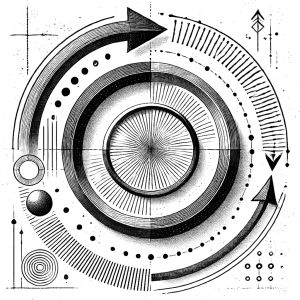InnerMotion – The Guidebook – Reconnection

Even the most intuitive dancers experience moments of disconnection - whether due to distraction, overthinking, emotional shifts, or simply pausing for a break. To regain that meditative state of flow, it helps to have a structured and familiar process - one you’ve practiced enough that it feels natural and effortless - to guide you back into a dance.
Rather than forcing yourself to move, this technique provides a personalized sequence of steps that serve as a bridge between stillness and conscious movement. Every dancer should develop their own reconnection process, but the goal remains the same: to return to dance in a way that feels natural, embodied, and enjoyable. Below is a sequence that works well for me, but feel free to adapt it to your own needs:
- Pause and Reset: Instead of forcing movement, come to a complete stop. Fully acknowledge the moment of disconnection without judgment. Sometimes, stopping is the first step in regaining control of your experience.
- Embodiment: Engage in the Embodiment Quick Reconnection technique to bring awareness back to your body. This may include a short body scan, a deep grounding breath or closing your eyes. The goal is to shift your focus from thoughts to physical sensations.
- Embrace Emotions: If emotions surface - whether frustration, self-consciousness, or excitement - acknowledge them. Instead of resisting or suppressing how you feel, let these emotions flow into your movement.
- Connect with the Rhythm: Shift your focus to the beat. Feel the rhythm deep within your core muscles, allowing it to move your abdomen and hips. Let the music ground you before adding more movement.
- Expand to More Musical Layers: Once anchored in rhythm, begin expanding your awareness to other elements of the music - the melody, harmonies, textures, and dynamic shifts. Let these layers naturally guide your movement, flowing into your arms, legs, head, or spine.
- Move Through Space: As you regain connection, begin expanding outward - not just in place, but through space. Changing directions, shifting levels, and traveling through your environment help reignite momentum, preventing hesitation or overthinking.
- Let Go and Enjoy: By now, you should feel reconnected. Release any lingering tension or control and surrender fully to the experience. Enjoy the freedom of movement, allowing your body and the music to merge effortlessly. As you deepen your practice, you may choose to transition into any of the advanced techniques found in the next chapters of this guide. Once learned, these techniques can serve as entry points into even deeper states of flow and awareness.
Every dancer experiences moments of disconnection differently, and the path back to flow is unique for each individual. Take the time to explore and refine your personal Reconnection process by asking yourself:
- What typically causes you to disconnect? Is it overthinking, external distractions, fatigue, hesitation, emotional overwhelm, or even physical discomfort? Do certain environments make it harder for you to stay engaged, like dancing in a crowded space or under bright lights? Would adjusting your setting, such as closing your eyes or focusing on a single point in the room, help you stay present?
- What sensations help you return to movement? Do you find it easier to reconnect by tuning into your heartbeat, shifting your weight side to side, feeling the temperature of the air against your skin, or sensing the vibrations of the music through the floor? Some dancers find that small repetitive movements, like swaying or tracing circles with their hands, can act as a bridge back into deeper expression.
- What mental shifts help you let go of self-consciousness and surrender to the moment? Would a verbal cue or internal mantra help? Would shifting your focus to a specific intention or emotion - such as dancing for joy, release, or exploration - help you move without hesitation?
- How does music play a role? Do you reconnect best by isolating a single instrument, humming along, or physically mimicking the quality of a sound with your movement? Do you need to match the intensity of the song, or does moving against the beat help shake you out of a stuck state?
- What type of movement helps you transition back into flow? Do you need to start with structured movements, like repeating a specific motion, or does freeform, spontaneous movement work better for you? Would shifting between different movement qualities (sharp vs. fluid, fast vs. slow) help reignite your creativity?
- How does your breath influence your movement? Does taking a deep inhale before initiating movement help you feel more grounded? Do you notice that shallow breathing correlates with feeling stuck, and would intentionally exhaling with movement help release tension?
- What role does physical space play in your reconnection process? Do you feel more comfortable dancing close to others or having space around you? Would changing your position in the room - moving to the center, a corner, or the edge of the dance floor - help reset your focus?
- Does interacting with others help or hinder your ability to reconnect? Would mirroring someone’s movement, exchanging eye contact, or using a playful interaction bring you back into flow? Or do you find that reconnecting first within yourself before engaging with others works better for you?
- How does your emotional state affect your movement? Do you notice that certain emotions cause you to tense up, freeze, or withdraw? What happens when you intentionally move as if expressing that emotion rather than resisting it?
Your Reconnection process should feel like a trusted tool - something you can rely on without overthinking. Experiment with different sequences, adjust what doesn’t feel natural, and practice until it becomes second nature. With time, your ability to transition effortlessly back into dance will become instinctive, removing any fear of losing connection. By mastering Reconnection technique, every pause becomes part of the dance rather than an interruption.